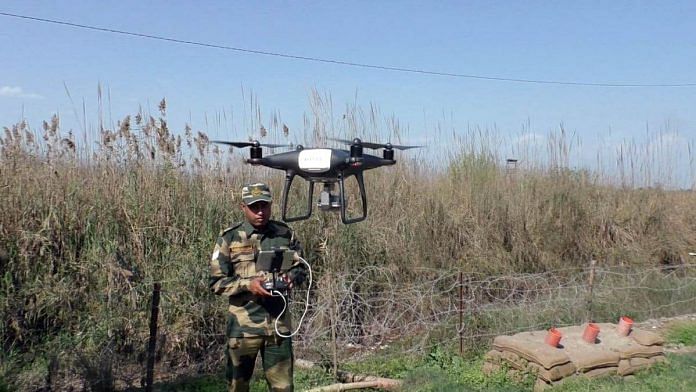New Delhi: From social media vloggers and crop analysts to wedding photographers and disaster relief personnel — drones have become an inseparable asset across a whole range of spheres.
On Sunday, after the drone attack at the Jammu Air Force station, the unmanned aerial vehicles have come to symbolise a new terror challenge for India.
The threat was further emphasised when, between Sunday night and Monday morning, two drones were spotted over the Ratnuchak-Kaluchak military area. The drones escaped after Army personnel fired at them.
While an investigation is underway into the drone attack at Jammu, defence sources speaking to ThePrint did not rule out the possibility of a regular, non-military drone having been used.
Civilian drones — which are easily available for purchase in India, including Chinese products — come in different sizes and weights.
The Indian government has framed rules to govern the operations of drones — the first of these came in 2018, with an update this year — but experts say any guidelines are unlikely to avoid an attack like Sunday’s. Rogue drones, they say, are hard to rein in.
Also read: Jammu drone attack, a first in India, signals new terror challenge. NIA could take over probe
Drones in India
Drones are unmanned aerial vehicles that can be manoeuvred remotely by a pilot.
The Indian drone industry is currently in its nascent stages. According to a Forbes report from June 2020, there are “200,000 recreational and commercial drones in the country, each costing anywhere from Rs 200,000 ($2,600) to Rs 20 million ($26,000) depending on size and functionality”.
A July 2018 report by FICCI-Ernst & Young estimated that India’s drone industry will touch nearly $900 million by 2021.
Sources in the government told ThePrint that there are over 30 registered firms in India that are involved in making or assembling different types of drones.
Based on their weight, drones can be divided into five categories — nano (weighing up to 250 g), micro (250 g to 2 kg), small (2-25 kg), medium (25-150 kg), and large (over 150 kg). All drones except nano require a licensed pilot and permit from the Director General of Civil Aviation (DGCA). Altitude and speed restrictions also vary depending on the category of the drone.
The Unmanned Aircraft System Rules, 2021, set certain conditions for operating drones. For one, it prohibits the flying of drones in Delhi’s Vijay Chowk, areas surrounding strategic locations notified by the Ministry of Home Affairs, central secretariats in state capitals, and eco-sensitive zones.
Operating drones is also barred within 5 km of international airports at Mumbai, Delhi, Chennai, Kolkata, Bengaluru and Hyderabad, and at a distance of 3 km from the perimeter of any civil, private or defence airport.
Drones cannot be flown within a distance of 25 km from international borders, which includes the Line of Control, and in the vicinity of military installations or areas where military activities take place (unless clearance is obtained from the local military facility).
Under the rules, individuals and companies are required to obtain the DGCA’s approval to import, manufacture, trade, own or operate drones.
Further, any individual importing, manufacturing, trading, owning or operating drones must be a citizen of India and above 18 years of age.
Violations can mean a fine ranging between Rs 25,000 and Rs 50,000.
Nano drones can be easily purchased online, including those by Chinese giant DJI. In 2018, the brand reportedly took exception to policy guidelines that required every drone to fulfil certain conditions for permission to operate in India.
The top drone manufacturers in India currently include ideaForge, Asteria aerospace, Aarav Unmanned System (AUS), IOTech, and Hubbal Fly.
The cost of a drone depends on its application and capabilities. For instance, a drone used in the agriculture sector to spray pesticides can cost anywhere between Rs 5 lakh and Rs 10 lakh; a survey-mapping drone can cost between Rs 8 lakh and Rs 12 lakh; defence ones can cost anywhere from Rs 5 lakh to Rs 1 crore, depending on specifications and endurance.
According to a 2020 report by the Drone Federation of India (DFI), urban planning, monitoring wildlife and preventing illegal activities in forests, capturing and analysing data for Indian Railways, National Highways Authority of India and state governments for transportation plans, mining, disaster management, agricultural assessments and security and surveillance are some of the ways in which drones are being used in India.
‘Rogue drones’
Experts say despite the rules, rogue drones can turn out to be a major security threat, given that they can be used for still photography, video filming, and recceing a potential spot for future action.
“The drones can be used for vital intel gathering and with respect to vital assets and stores,” a source in the Indian military told ThePrint.
“The cameras are so powerful you can be two km away and at a higher altitude but you can zoom in with deadly accuracy and precision,” the source said.
“The growing number of people buying and using drones is a major challenge. The new regulations by the government have their limitations and they [drones] are extremely difficult to detect,” the source added.
On the Jammu incident, Smit Shah, director of partnerships at the DFI, said, “The best of drone policies cannot address what happened in Jammu. If someone wants to assemble a drone and fly it in any part of the country, they have the physical capabilities to do so.
“No liberal or strict policy can address the issue of rogue drones. We need to develop technical capabilities in the counter drone domain where technology is used to either detect, identify or kill rogue drones. We have a few companies who do this work but a greater focus is needed.”
(Edited by Sunanda Ranjan)
Also read: We were shocked, woke up to deafening sounds of explosions — residents on Jammu drone attack



